Welcome to the forums at seaphages.org. Please feel free to ask any questions related to the SEA-PHAGES program. Any logged-in user may post new topics and reply to existing topics. If you'd like to see a new forum created, please contact us using our form or email us at info@seaphages.org.
Recent Activity
Debbie Jacobs-Sera posted in Validating Translational Frameshifts in DNA Master
storksle posted in Validating Translational Frameshifts in DNA Master
Debbie Jacobs-Sera posted in Validating Translational Frameshifts in DNA Master
Lee Hughes posted in Validating Translational Frameshifts in DNA Master
storksle posted in Validating Translational Frameshifts in DNA Master
All posts created by GregFrederick@letu.edu
| Link to this post | posted 24 Mar, 2016 17:58 | |
|---|---|
|
|
I realized I put this in the wrong place… But I also just figured out that phamerator is capable of the Pham circles. Any thoughts on Phylogenetic trees? |
| Link to this post | posted 23 Mar, 2016 14:15 | |
|---|---|
|
|
Which softwares are best for producing Pham circles and Phylogenetic trees like those depicted in this reference? https://www.researchgate.net/figure/250926373_fig13_A-B-Pham-circles-for-phams-3687-A-and-6944-B-Phage-names-are-organized-by Thanks for your suggestions. Greg |
| Link to this post | posted 07 Mar, 2016 15:36 | |
|---|---|
|
|
Thanks guys! |
| Link to this post | posted 04 Mar, 2016 17:48 | |
|---|---|
|
|
Thank you for all that info! GF |
| Link to this post | posted 03 Mar, 2016 23:30 | |
|---|---|
|
|
So are CDDs the number that is associated with the features in Phamerator? (Not the number hovering above each feature? What are these numbers, BTW?) Some of the yellow boxes have actual gene functions. So am I right that those do not have CDDs listed? |
| Link to this post | posted 03 Mar, 2016 22:56 | |
|---|---|
|
|
We are almost finished with the annotation of our first two genomes. We have added multiple genes that DNA Master did not call originally. QUESTION: Is there a way to manually input our nearly completed sequence into Phamerator to see what how it compares to similar sub-cluster phages? If so, how? If not, this would be a really nice feature to add. (I'm guessing the feature is already available. So please tell me how.) Thanks. |
| Link to this post | posted 03 Mar, 2016 22:52 | |
|---|---|
|
|
We are almost finished with our annotation of our first two genomes. We have added multiple genes that DNA Master did not call originally. QUESTION: Is there a way to manually input our near completed sequence into Starterator to see what it thinks about the start codons we have chosen? If so, how? If not, this would be a really nice feature to add. (I'm guessing the feature is already available. So please tell me how.) Thanks. |
| Link to this post | posted 24 Feb, 2016 15:26 | |
|---|---|
|
|
joyous726 DId you get any responses to these questions outside the forum? Were your students successful? I have some questions too. We found what I think is an interesting mutant that I would like to investigate further. My email address is GregFrederick@letu.edu if you would rather communicate through email. Thanks. |
| Link to this post | posted 18 Feb, 2016 19:59 | |
|---|---|
|
|
One of our teams noticed this as they were annotating and brought it to my attention this morning. The stop codon is about midway in the gene compared to all the other finished A6 phage genomes. He noticed the obvious mis-alignment of the two "features" the stop produced. The second feature was called from the next in-frame start codon after the stop. When he started blasting the homology of both to different regions of the same gene popped out at him. On to the science question: I am I correct in understanding that if the gene for the "immunity repressor protein" is inactivated lysogenized cells should be super-infectable by another A6 phage when normally they would likely not be were a functional protein produced? Is there an easy experimental method available to test for the inactivation of the immunity repressor protein? Is this even remotely interesting? I phamerated all the finished A6 genomes and did not find any others with this interrupting stop codon. Do we know of any other cases with this protein is disruppted? Can you think of any other interesting experiments that might be useful to conduct with this phage or lysogenized cells? Thanks for helping me brainstorm how discovery of this point mutation might be utilized further. Thanks. Greg |
| Link to this post | posted 18 Feb, 2016 19:51 | |
|---|---|
|
|
Lee HughesGregFrederick@letu.edu I have to say I don't remember the names of the other phages. (Can I blame it on old age even though I don't like to use that card?) It's been more than a few days and a few genes examined since I was doing those Phamerator alignments. I'll try to pull up more of the subcluster into Phamerator in class this afternoon and let you know. Thanks. |

